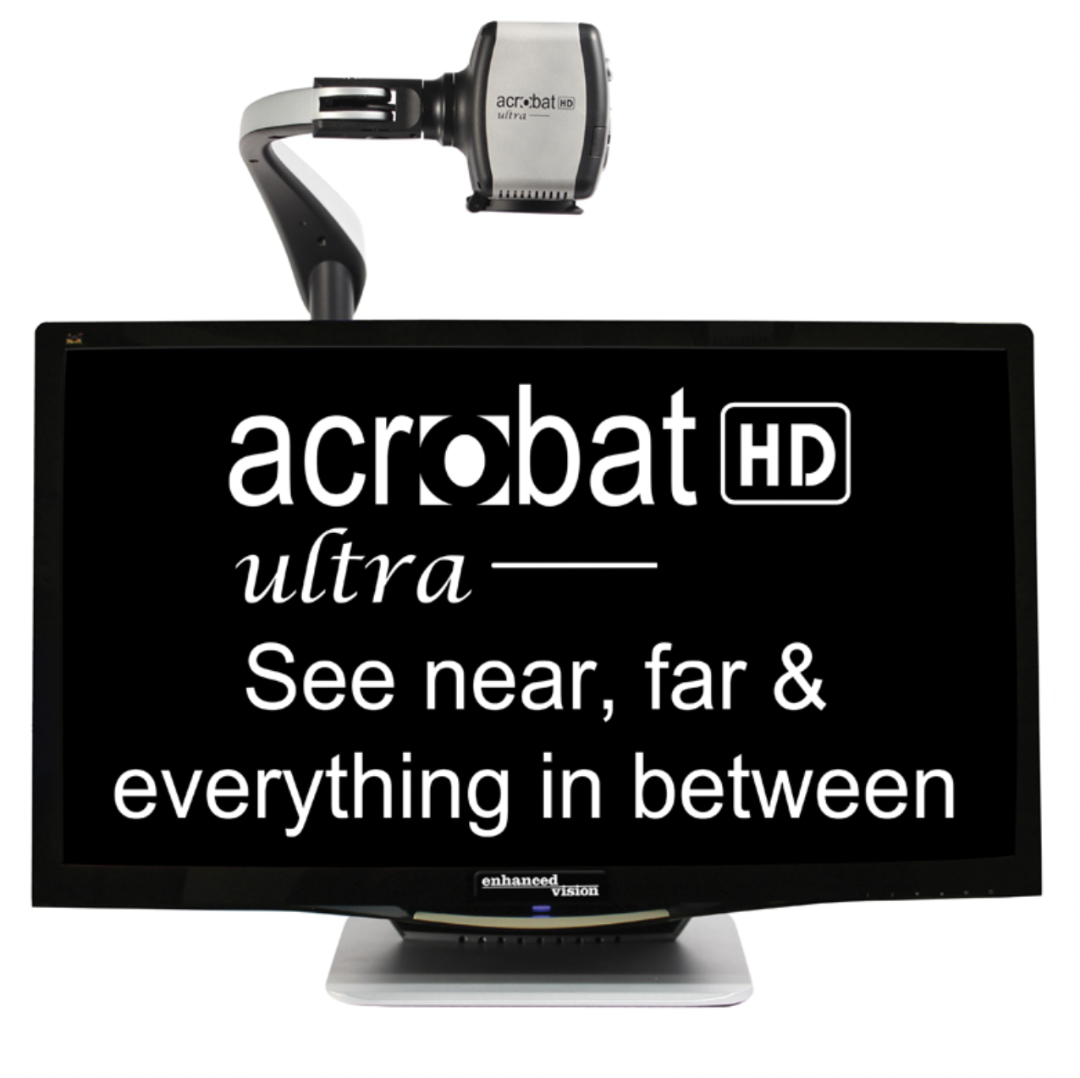Enhanced Vision Acrobat HD ultra LCD – High Definition Images in Bright Vivid Colors
Enhanced Vision Acrobat HD ultra LCD – High Definition Images in Bright Vivid Colors
Share
SKU:ACDUE22A
Hurry, only 1 left in stock
Couldn't load pickup availability
We accept







Acrobat HD ultra’s new Full HD 3-in-1 camera provides the best image quality available today! Enjoy brighter sharper colors and bold contrast with this feature rich electronic magnifier. A wider field of view allows you to see even more of what you want.
It’s our most flexible solution for reading, writing or viewing magnified images at any distance. Use it up close like a mirror for applying make-up or other personal grooming.
By simply rotating the camera you can magnify images in the distance. Use it to view presentations, paperwork, even work on crafts and hobbies. Acrobat HD ultra is ideal for work, school or home.
ACROBAT HD ULTRA LCD is a complete system featuring a 3-in-1 Full HD camera with a 20”, 22”, 24”, or 27” high resolution HD LCD producing maximum picture detail for clear, vivid color display.
The adjustable arm, tilting screen, and rotating capability allows the camera to be positioned at any angle for optimal viewing.
Features:
- Full HD 1080p auto focus 3-in-1 camera for seeing yourself up close, reading and distance viewing
- Light on/off feature
- Three position monitor height adjustment provides maximum flexibility
- 28 available viewing modes to optimize contrast and brightness
- True mirror image in self-viewing mode
- Remote control unit features instant on/off (standby)
- Memory setting for each HD camera position
- Compact size minimizes space needed on table or desk
- 28 available viewing modes to optimize contrast and brightness
- Line markers and object locator
- Remote control unit features instant on/off (standby)
- Computer compatible (additional hardware required)
- 20”, 22”, 24” or 27” high resolution HD LCD monitors provide 1.4x to 71x adjustable magnification (varies with LCD size)
- Set up is easy, just plug in and begin
- 2 year warranty
- Designed and Assembled in the USA
Specifications
Product Dimensions:
20” LCD: 21”H x 19”W x 8”D (53cm x 48.25cm x 20cm)
22” LCD: 21”H x 20”W x 8”D (53cm x 51cm x 20cm)
24” LCD: 21”H x 22”W x 8”D (53cm x 56cm x 20cm)
27” LCD: 21”H x 25”W x 8”D (53cm x 63.5cm x 20cm)
Product Weight:
20” LCD: 18.4 lbs / 8.35 kg
22” LCD: 18.6 lbs / 8.5 kg
24” LCD: 19.6 lbs /8.9 kg
27” LCD: 21 lbs / 9.5 kg
Display:
Type: TFT Active Matrix LCD Average lifetime: 25,000 hours
Monitor (common to *20”, *22″,*24 & *27″ models):
Resolution: 1600 x 900 (20″ model)
Resolution: 1920 x 1080 (22”, 24” & 27″ models)
Response Rate: 5 milliseconds (20”, 22″ & 24″ monitors)
Response Rate: 3 milliseconds (27” monitor)
* all monitor specifications subject to change without prior notice
Magnification range:
20” LCD: 1.4X (minimum) – to 52.5X (maximum)
22” LCD: 1.5X (minimum) – to 57.8X (maximum)
24” LCD: 1.6X (minimum) – to 63X (maximum)
27” LCD: 1.8X (minimum) – to 70.9X (maximum)
20”, 22” 24” Field of View (Near Mode): 10.8 inches (min); .24 (max)
27” Field of View (Near Mode): 11.6 inches (min); .24 (max)
20”, 22” & 24” Working Distance (Near Mode): 17 inches
27” Working Distance (Near Mode): 18.4 inches
Video output Resolution on LCD:
SMPTE 292M – HD 1080p 60/50Hz
Viewing Modes:
Color, Black & White, High Contrast, Positive/Negative, Digital Color Select (5 modes)
Power Supply:
Input voltage/current: 120-240 VAC / 0.3-0.5A (nominal)
Frequency: 60/50 Hz
Power usage: 27W (nominal)
Equipment Classification: (IEC 601-1)
Type of Protection: Class 1
Degree of Protection: Type B
Mode of Operation: Continuous
Operating temperature range: 10-40°C / 50-104°F
Storage/transport temperature range: 0-60°C / 32-140°F
Warranty: 2 years


